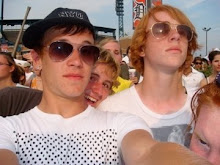 The astounding thing about reading Will Eisner's The Spirit is the timelessness. I'm striving to find a word that really captures what I mean, but words just can't sum up the place this work still holds in the canon of comics. In many ways, the uneducated would probably place these stories much later on the timeline of comics than the 1940's.
The astounding thing about reading Will Eisner's The Spirit is the timelessness. I'm striving to find a word that really captures what I mean, but words just can't sum up the place this work still holds in the canon of comics. In many ways, the uneducated would probably place these stories much later on the timeline of comics than the 1940's. Eisner defies his time of origin with an art style that takes the best of his animation background and mixes in fine art skills and a sense of what works and what fails on the page. This seemingly effortless knowledge isn't possessed by many today; the way that Eisner allows his images to tell stories on their own could deliver a much-needed lesson to the overbearing writers to emerge after Stan Lee's revolution. While much of the credit is certainly due to Eisner being a cartoonist (i.e. writing and drawing instead of working in tandem with another creator), the restraint is still remarkable. Fight scenes are given the space to speak for themselves, and internal narration only ever complements images, never struggles for dominance. Whereas cracking open a Chris Claremont issue of X-Men will reveal captions and thought balloons that explain, in detail, everything occurring on panel, Eisner wisely uses his narration to explain things that can't accurately be portrayed through art: changes in speed and sound, thoughts that the thinker wishes to hide from those around him, etc.
Eisner also lays down a foundation for panel staging that has only recently (relatively speaking) been expanded upon, and even now with mixed results. Eschewing the legacy of comic strips, which often featured pure side shots of characters, scenes that are akin to adjacent animation cells, Eisner panned his "camera" to suit his story. I was blown away by the panel that features the titular character recovering from a punch at the far end of the panel, the bulk of the space taken up by wood flooring. This panel expertly, but subtly, communicates the distance the punch sent him, the spatial relationships between characters, and the implied movement (if only Frank Miller hadn't "directed" an awful film version a while back, I might have a chance to find an example of such a panel online). Eisner manages to preemptively break out (literally and figuratively) of the constrictions that later artists will adhere to concerning panel structure. Mixing "widescreen" layouts with small squares panels, allowing certain panels to have differing borders or none at all, Eisner layed down a groundwork that wouldn't be seen again in mass form until decades later.

As for his noir style, the influence is obvious and practical. Eisner's style was at once cartoony and meticulous, and the heavy "shadows" (re: inks) allowed him the time to focus on what would be shown. In sharp contrast to the almost offensively bright superhero adventures that would fill the pages for years to come, Eisner's Spirit used shadows to guide the eye, to focus attention, and to create tension. For years, this sense of light was lost to the medium, but Eisner nailed it in his first few outings. Most importantly, and something that creators still often fail to capture, Eisner does it all with a sense of fun. It is evident from the outset, as his covers often playfully acknowledge the medium by having characters interact with the typography of the page. Not willing to try to pass off a subpar imitation of another medium (film, animation), Eisner makes a bold statement that comics is a singular medium capable of its own path and its own style. How much of that style saw its first appearance here wouldn't be evident for years to come, but it is inescapable now.

Stephen,
ReplyDeleteI loved the artwork you included at the top -- the "visual obit" of Gerry Alanguilan (see his Wikipedia bio):
http://en.wikipedia.org/wiki/Gerry_Alanguilan
He is the first Filipino comic book artist that I have come across. And, the cartoon-obit. was a wonderful tribute to Eisner and to Eisner's STORY OF GERHARD SHNOBBLE. According to Eisner in the documentary film on him, GERHARD SHNOBBLE was his favorite story that he wrote. And, THE SPIRIT was only tangentualy referenced in this story.
This was your best summation or BLOG report. You both cited story and artwork ideas I loved your comments on "panel staging." Awesome analysis of that, use of shadows (and giving specific examples) and how the characters interact with the typography on the page.
Cynthia